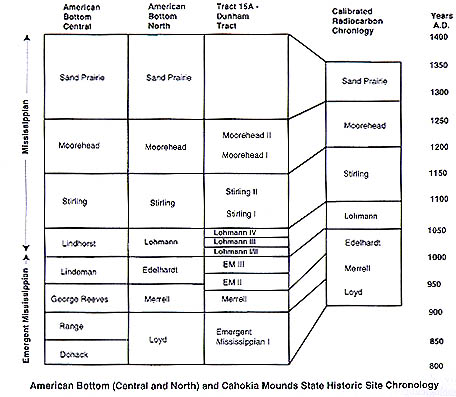
In one reconstruction (Emerson 1995, 1997), developing complexity of religious and civic functions of nodal settlements, villages, and towns occured simultaneously with increasing complexity at Cahokia. That is, changes in the socio-political environment at Cahokia are mirrored at smaller, rural American Bottom sites. According to this view, the appearance of non-residential structures, and some exotic materials in Emergent Mississippian villages occurs at the same time as the initial mound construction and population growth at Cahokia. As mound building, ritual mortuary practices, and influx of exotic items increased during Lohmann Phase at Cahokia, other mound centers appeared in the American Bottom. At Cahokia, there appears to have been a complete reoranization of residential and non-residential space; plazas and mounds were built so to form a sacred, elite space. The founding of other mound-towns with plazas appears to represent the formation of an elite throughout the American Bottom, probably with direct ties to Cahokia. At the florescence of Cahokia during the Stirling Phase, small mound centers continued to grow and others like Mitchell were established. In the Stirling Phase symbols of chiefly power became strongly intertwined with those of the supernatural and the cosmos. Finally, the abandonment of mounds, shrinking population, and the reduction in the influx of exotic materials and finely crafted goods that mark the decline of Cahokia in the Sand Prairie Phase are mirrored by changes in the rural socio-political landscape. Farmsteads and hamlets were abandoned as the rural population coalesced into dispersed villages, returning to a settlement pattern much like that of the earlier Emergent Mississippian.